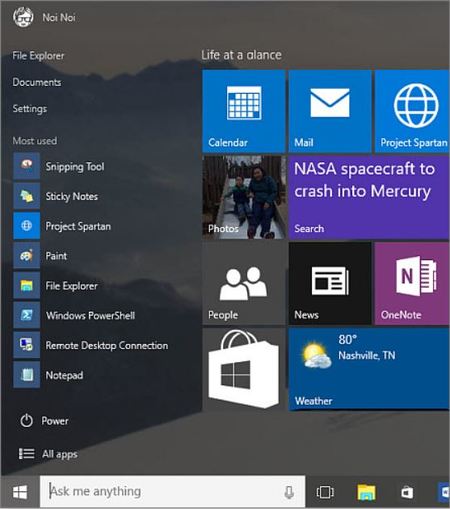|
Microsoft has been extremely active the last few weeks, holding several conferences -- its Build gathering in San Francisco about technology development, and an Ignite event in Chicago this week for business users. In large part, I assume, that's because the release of Windows 10 is coming very soon. The latest rumors are that it will may be released as early as in July.
Everything I've been reading from reporters who've had hands-on experience -- and from watching online streaming of the conferences -- is confirming what I've been writing about Windows 10. It appears to be not only leaps better than Windows 8.1 (which I quite like), but light-years ahead of Windows 8, that worked okay at best but was quite problematic and got decidedly mediocre press. But Windows 10 appears to be wildly innovative. And is getting very positive advance word. I'm going to do my best not to be all techie here, but instead just describe what all of this means for users in human terms, rather than write about specs. And rather than go into voluminous features, I'll just focus on a couple of things that are most noteworthy about what Windows 10 means, both for users and the computer world.. First, the biggest complaint about Windows 8 (and to a lesser-degree, 8.1) is that the Start button disappeared from the Desktop. Instead there were two interfaces that confused a lot of people -- one interface was the familiar Desktop (except that it had no Start button, so it wasn't familiar enough) and the other was the "Metro" view for tablets, which had Metro-style apps It really wasn't all that challenging once you realized what was going on, but it wasn't intuitive and was far from ideal. That's all gone. Now, the Start button is not only comfortably back on the Desktop, but it's blended with Metro view, making Windows 10 now a seamless experience. The Metro interface still is there, if you're working on a tablet, but Windows 10 now recognizes what device you're using and automatically adjusts itself to the proper interface. Moreover, the Start button not only provides all the Desktop links like you're used to in a list-- but links to Metro app tiles, as well. And you can pin Metro apps to the Desktop's Taskbar. What this means is that you no longer have to switch back and forth between the desktop view and Metro view. It's all the same, all blended together. You can just stay on the Desktop, if that's your preference, and get the best of both worlds. That brings up the issue of Metro apps, which I've been mentioning. And this might not only be the biggest change with Windows 10, but -- if it works (and right now, there's no indication yet that it won't), it may change the landscape of computing. Yes, I know that's a big statement, but let me explain. Right now, Windows tablets and the Windows Phone are a distant third to Apple's iOS and the Android operating system. A significant reason is the widespread availability of high-quality apps. (In part, this is just perception, since there are 500,000 Windows apps. However, the quality isn't always the same as with other platforms, and some important apps don't exist for Windows.) This will change because Metro apps have changed, hugely. Their name has changed, too -- first to Universal apps, and now they're called simply Windows apps. Names aside, here's the point and big deal about the new, much-improved Windows apps Any app written specifically for a Windows tablet will now work on...everything. It will run on a desktop or laptop computer, as well as on a Windows Phone, and on an Xbox. And on a Smart TV. The code won't have to be re-written for every device, as is the case with apps for other operating systems. Now, when a developer writes the code now for a Windows app...it will work on every Windows device, readjusting itself automatically to the format. This is significant. (Quick note. There's another advantage to using Windows -- or Universal -- apps. The way their code is written, the apps reside in a "sandbox" environment within Windows 10, making them protected against virus attacks. Only apps that are in this safe sandbox are able to run on Windows 10.) So, why might all this change the computing landscape? The main reason that previous apps for Windows have lagged behind their competitors is because the sale of Windows tablets and Phones have lagged far behind Apple and Android devices, and it therefore hasn't been worth the while for developers to write apps for them. (That's made this a sort of self-perpetuating, vicious cycle. ) But -- if an app written for Windows on desktop computers, with their massive user base, will also work on a Windows tablet and Windows Phone and Xbox, then suddenly there is every reason to write apps for the platform. And since Microsoft is making the upgrade to Windows 10 free, this Windows user base should increase exponentially. In fact, the company says that within just 2-3 years, they expect there to be one billion computers running Windows. That, folks, is a huge user base to write apps for. And those apps, as I said, will also work on any Windows device. So, now, that previous reason people used for not getting a Windows portable device, the lack of quality apps across the board, disappears. Moreover, now it will be seamless to work on all your devices, which will be using the exact same apps, not "similar" versions. But it goes deeper than that, and it leads to a related leap forward. At the Microsoft Build conference two weeks ago, the company announced plans that would allow an easy way for developers to bring iOS and Android apps into becoming Windows apps for Windows 10. In other words, any existing app for iOS and Android will be able to be easily converted into a Windows app. So, that divide may be bridged even further. (The developer still has choose to convert it, of course) Similarly, Microsoft is developing code that will be able to take legacy pre-Windows 10 standard programs (like your Quicken, or Photoshop) and convert them into Windows apps -- which will then run on all Windows devices. Now, mind you, there is a big caveat with all this. And that's the jackpot question of whether Windows apps will work universally as planned. And that caveat is -- this is major undertaking. It could crash and burn. There's no absolute certainty that it will work. However, assuming that all this does work – and in all my reading I haven’t yet seen that Windows apps aren’t working – and assuming that the other features I've seen for porting other apps into being Windows apps also works, then those are massive, game-changing, quantum jumps forward. Now, to be clear, that's a lot of "assumings". It might not work, or work as easily as hoped. But with the release of Windows 10 so near, it's not like we're talking about some distant theory cooked up in a lab on a hope and prayer. This has been under a microscope and been beta-tested for a long while. And it's expected to be sent into the world in maybe less than three months. Indeed, at this late date, the biggest question mark I’ve read is not so much if the conversion technology works, but if it will work easily enough for developers to create universal Windows apps. But again, as I said, given that this is what has been developed, and the release is near, if all this does indeed work as built, then with the massive user base of Windows desktop computers worldwide that could change the landscape for apps on Windows tablets and Phones. There's more to Windows 10, of course, but then we start getting techie and overladen with the minutiae of features. Some of these seem seriously impressive, but it's far too extensive to get into for our purposes here. This is just meant as an overview of what Windows 10 means for users and developers, and why it appears to be a fascinating leap in the world of computing. Suffice it to say that the core of Windows 10 has been tested extensively and very publicly, and the word is very positive, including from journalists who were harsh on Windows 8. (There's one other development, though, that I will mention. For the time being, I don’t care all that much about the highly-touted HoloLens, which is a hologram device Microsoft has developed to work with Windows 10. However, I saw a demo from the Build conference where they created a holographic "entertainment window" that was playing a movie and games, and then “attached” this window to a wall -- and then gave it a “follow me” command, and wherever the person walked in his house, this hologram window followed along on every wall. Whether or not that’s practical now, it’s nonetheless awfully impressive technology for the future.) The bottom line here is that, at the very least, this should put to rest (not that it will, since "Microsoft hater" is an almost-trademarked term in the Apple World ) any question about how innovative Microsoft is. Because by any reasonable and fair standard, this all incredibly innovative. The critical question of how it works, that remains to be seen. But it will be seen very soon. For those more interested in a more techie perspective, this is a nine-minute edited down version of the three-hour keynote address at the Build conference in San Francisco. The video is very well-done, put together by The Verge website. A lot is techie mumbo-jumbo beyond the understanding of most mortals -- but plenty of it is very clear, and there are a lot of visual demonstrations that are easy and fun to watch, including a great look at HoloLens.
0 Comments
Leave a Reply. |
AuthorRobert J. Elisberg is a political commentator, screenwriter, novelist, tech writer and also some other things that I just tend to keep forgetting. Feedspot Badge of Honor
Archives
June 2024
Categories
All
|
|
© Copyright Robert J. Elisberg 2024
|







 RSS Feed
RSS Feed